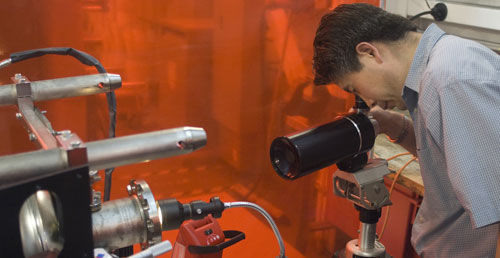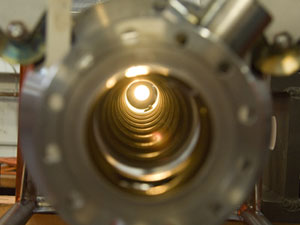
Rongli Geng zeros in on a defect inside this accelerator cavity with a long-distance microscope.
When an expensive accelerator component designed for the International Linear Collider failed to perform as expected, Jefferson Lab scientists set out to find the root of the problem. What they discovered and the tool they used to make their discovery could have widespread applications in accelerator science.
"You can see the cavity is about a meter long, with nine cells. Any defects on the metal surface, inclusions or even particulate contamination, will become a potential source of field-quenching or electron-emitting sites," said
Rongli Geng as he stood alongside the shiny niobium component.
It was Geng, a staff scientist at Jefferson Lab's Institute of Superconducting Radiofrequency Science and Technology, who found the problem with the cavity: a tiny metallic speck just a bit wider than a human hair on the cavity's internal surface. The cavity is one of eight ILC cavities processed and evaluated by Jefferson Lab staff thus far. The problematic cavity, which is the fourth manufactured by Advanced Energy Systems, has been dubbed AES4.
While conducting performance tests on AES4, Geng found that the cavity did not meet target specifications, likely due to two electron-emitting sites caused by surface defects. These sites leach away energy that would ordinarily go into accelerating subatomic particles, the accelerator cavity's main purpose. Emitted electrons heat up the cavity wall as they gain energy from the field stored in the cavity, giving scientists a method for locating emitting sites.
"We have a set of temperature sensors built by our JLab colleague Gigi Ciovati, which we attach to the outer surface of the cavity. They will tell which part of the cavity wall is hotter than the surrounding area, even very small temperature rises," Geng explains.

Rongli Geng is working to identify and remove defects inside this accelerator component designed for the International Linear Collider.
Once the sensors confirm which of AES4's doughnut-shaped cells have developed electron-emitting sites, Geng can scour the area for defects.
To make his search, Geng turned to a favorite tool of birders and backyard astronomers – a telescope.
"This is the Questar. The technical name is long-distance microscope," he said, pointing to the small telescope he had mounted on a stand. "The theoretical resolution of this tool is three microns. That is enough for our purposes."
Aiming the device at the inside surface of one of the suspect cells, Geng managed to quickly find a microscopic defect.
"There was a trick to this, and that was finding the correct source of illumination," Geng said. "We have successfully identified the defects in the cavity without actually inserting a camera into the cavity."
Scientists may not know exactly how the defect is formed, but Geng explained that the "defect can be introduced in the beginning. For instance, when you are forming the cups, you can have a defect embedded into the material and afterward, when you do the chemistry and remove the defect, you could leave a damaged site there. You could also have inclusions from the original material."
Geng and his colleagues are still deciding how they will remove the defect they found in AES4. "A typical fix would be just to mechanically remove it. It's not easy, though, because you are talking about the size of a human hair. You need to precisely go to that spot and remove it." The next step is to develop countermeasures to remove these defects.
Currently, the electron-emitting problem limits the performance of the cavity to roughly 28 Megavolts per meter, but Geng hopes that removing the defect will allow the cavity to eventually reach its 35 MV/m goal, making this cavity eligible for further testing.
JLab is working with other labs to develop the capability for realizing this ambitious project (ILC). Past experience in working with niobium accelerator components, used in JLab's CEBAF accelerator and in the Free-Electron Laser, allow lab staff to successfully tackle technical challenges in applications of superconducting radiofrequency technology. Further developments in the field, in return, pay dividends in reliability and performance of the CEBAF 12 GeV Upgrade and energy-recovering linear accelerators.
Some funding for this work was also provided by Japanese colleagues via the U.S.-Japan Agreement.
Further Reading:
Jefferson Lab Cooks Up the Perfect Cavity
Reaching New Heights in Accelerator Technology

